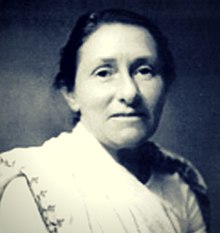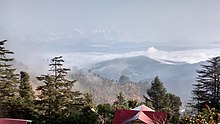Sarla Behn
Sarala Behn (born Catherine Mary Heilman; 5 April 1901 – 8 July 1982) was an English Gandhian social activist whose work in the Kumaon region of Uttrakhand, India helped create awareness about the environmental destruction in the Himalayan forests of the state. She played a key role in the evolution of the Chipko Movement and influenced a number of Gandhian environmentalists in India including Chandi Prasad Bhatt, Bimala behn and Sunderlal Bahuguna. Along with Mirabehn, she is known as one of Mahatma Gandhi's two English daughters. The two women's work in Garhwal and Kumaon, respectively, played a key role in bringing focus on issues of environmental degradation and conservation in independent India.[1][2][3][4]
Sarla Behn | |
|---|---|
 | |
| Born | April 5, 1901 |
| Died | July 8, 1982 Dharamgarh Women’s College |
| Nationality | United Kingdom |
| Other names | Catherine Mary Heilman |
| Known for | follower of Gandhi and key role in the Chipko Movement |
Early life
Sarla Behn, was born Catherine Mary Heilman in the Shepherd's Bush region of west London in 1901 to a father of German Swiss extraction and an English mother. Due to his background, her father was interned during the First World War and Catherine herself suffered ostracism and was denied scholarships at school; she left early. She worked for a while as a clerk, leaving her family and home and during the 1920s came in contact with Indian students in mannady who introduced her to Gandhi and the freedom struggle in India. Inspired, she left England for India in January 1932, never to return again.[5][6]
Life with Gandhi
She worked for a while at a school in Udaipur before moving on to meet Gandhi with whom she remained for eight years at his ashram at Sevagram in Wardha. Here she was deeply involved in Gandhi's idea of nai talim or basic education and worked to empower women and protect the environment at Sevagram. It was Gandhi who named her Sarla Behn.[1][7][8] The heat and bouts of malaria afflicted her at Sevagram and with Gandhi’s concurrence she headed out to the more salubrious climes of Kausani in the Almora district of the United Provinces in 1940. She made it her home, establishing an ashram and working to empower the women of the hills in Kumaon.[9]
While in Kumaon Sarla Behn continued to associate herself with the cause of India’s freedom movement. In 1942, in response to the Quit India Movement launched by the Indian National Congress under Gandhi, she helped organise and lead the movement in the Kumaon district. She travelled extensively in the region reaching out to the families of political prisoners and was imprisoned for her actions. She served two terms in prison during the Quit India Movement for violation of house arrest orders and served time at the Almora and Lucknow jails for nearly two years.[5][10]
Lakshmi Ashram

During her political activism in Kumaon, Sarla Behn was deeply impressed by the determination and resourcefulness of the women heading the families of the arrested independence activists but dismayed at their absence of self-worth when in response to her call for meetings they responded "Behnji, we are like animals. All we know is work, Meetings and other such social activities are meant only for men."[11] She then set to work to make them realise that they were not passive animals but rather "goddesses of wealth".[12]
This she aimed to achieve through the Kasturba Mahila Utthan Mandal, Lakshmi Ashram, Kausani, an institution she founded in 1946 with the aim of fostering women's empowerment.[11] It was named the Lakshmi Ashram after the wife of the donor of the land.[13] The ashram which began with only three students imparted education to girls through the Gandhian idea of nai talim with its focus on not just academics but also on manual labour and holistic learning. Since its inception, the Ashram has produced several notable reformers and social workers including Vimala Bahuguna, Sadan Misra, Radha Bhatt and [14][15] Basanti Devi.[16]
Activism
Although Sarla Behn is best remembered for her role as an environmental activist who helped shape and spearhead the Chipko movement, she was also associated with the Gandhian movements led by Acharya Vinoba Bhave and Jai Prakash Narayan. After she had handed over the reins of the Ashram to Radha Bhatt, she worked with Bhave on the Bhoodan movement in Bihar in the late 1960s and with Narayan and the families of surrendered dacoits in the Chambal river valley in the early 1970s.[5][6]
Sarla Behn’s role as an environmental activist was even greater, and together with Mirabehn she helped shape a response to the environmental crisis engulfing the Himalayan region. As the activist-academician Vandana Shiva notes, "While the philosophical and conceptual articulation of the ecological view of the Himalayan forests has been done by Mirabehn and [Sunderlal] Bahuguna, the organisational foundation for it being a women’s movement was laid by Sarla Behn with Bimla Behn in Garhwal and Radha Bhatt in Kumaon".[17]
Under Sarla Behn's guidance the Uttarakhand Sarvodaya Mandal came into being in 1961 with principal aims of organising women, fighting alcoholism, establishing forest based small scale industries and fighting for forest rights. Throughout the 1960s the Mandal and its members worked actively towards these ends. In the wake of the Stockholm Conference of 1972, Sarla Behn initiated the Chipko Movement which began with a popular demonstration in the Yamuna valley at a site where colonial authorities had shot dead several activists in the 1930s for protesting against the commercialisation of forests.[18][19] The term 'Chipko' (which means to hug) came to be associated with the movement only later after the villagers decided they would hug the trees to prevent them from being felled and the name was popularised through the folk songs of Ghanshyam Sailani. In 1977, Sarla Behn helped organise activists and consolidate the Chipko movement in its resistance to lumbering and excessive tapping of resin from the pine trees.[4][20]
Sarla Behn was a prolific author, writing 22 books in Hindi and English on issues of conservation, women's empowerment and environment including Reviving Our Dying Planet and A Blueprint for Survival of the Hills.[1][8][21] Her autobiography is titled A Life in Two Worlds: Autobiography of Mahatma Gandhi's English Disciple.[22]
Death and commemoration
In 1975 Sarala Behn moved to a cottage at Dharamgarh in Pithoragarh district where she lived until her death in July, 1982. She was cremated according to Hindu rites at the Lakshmi Ashram.[23] She was a winner of the Jamnalal Bajaj Award[24][25] and on the occasion of her 75th birthday called the "daughter of the Himalaya" and the "mother of social activism" in Uttarakhand.[21][26]
Ever since her death, the Lakshmi Ashram commemorates her anniversary by hosting a gathering of Sarvodaya workers and community members to discuss and chalk out strategies for dealing with pressing social and environmental issues.[13] In 2006, the Government of Uttarakhand announced that it would set up a Sarla Behn Memorial Museum in Kausani.[23]
Legacy
Sarla Behn's influence on Uttarakhand in particular and Indian environmentalism has been significant although she remains a relatively unknown figure. She played a key role in inspiring grassroots organisations in Uttarakahand and helped spread the Sarvodaya movement in the state.[23] Besides several environmentalists, she also influenced the author Bill Aitken.[27] Her activism and the ashram she established helped, as the historian Ramachandra Guha notes, "groom a new generation of social workers, among them such remarkable activists as Chandi Prasad Bhatt, Radha Bhatt and Sunderlal Bahuguna. In the 1970s, these activists started the Chipko Movement, while in turn training the next generation of activists, those who led the movement for a state of Uttarakhand."[28]
References
- "Sarala Behn remembered". The Tribune. 5 April 2012. Retrieved 29 May 2013.
- "Indian Women Freedom Fighters" (PDF). Bhavan Australia (7.2): 15. August 2009. Archived from the original (PDF) on 21 July 2015. Retrieved 29 May 2013.
- Katz, Eric (2000). Beneath the surface: critical essays in the philosophy of deep ecology. Massachusetts Institute of Technology. p. 251. ISBN 9780262611497.
- Shiva, Vandana. "THE EVOLUTION, STRUCTURE, AND IMPACT OF THE CHIPKO MOVEMENT" (PDF). Ecospirit. II (4). Retrieved 29 May 2013.
- "SARALA BEHN". Retrieved 29 May 2013.
- "Sushri Sarala Devi" (PDF). Jamnalal Bajaj Foundation. Retrieved 7 June 2013.
- Behn means sister in Hindi. It is usual to call women that way in India.
- Dash, Siddhartha (August 2010). "Role of Women in India's Struggle For Freedom" (PDF). Orissa Review: 76. Retrieved 29 May 2013.
- Ganesh, Kamala (2005). Culture and the Making of Identity in Contemporary India. New Delhi: Sage Publications. p. 149. ISBN 9780761933076.
- "A WOMAN OF COURAGE (ENGLISH VIII - STANDARD)". Government of Tamil Nadu. Retrieved 29 May 2013.
- "A Woman with Rocklike Determination" (PDF). Manushi (70): 13. May–June 1992. Retrieved 29 May 2013.
- Ganesh, Kamala (2005). Culture and the Making of Identity in Contemporary India. New Delhi: Sage Publications. p. 150. ISBN 9780761933076.
- "NEWS FROM LAKSHMI ASHRAM" (PDF). Sanchar (108): 2, 6. March 2010. Retrieved 29 May 2013.
- "Nayee Taleem- A Method of Teaching Enunciated by Mahatma Gandhi". Retrieved 29 May 2013.
- Frank Sure Success in CBSE English Core (Reading, Writing and Literature). New Delhi: Franksons. 2008. p. PM-4. ISBN 9788184097528.
- "President Pranab Mukherjee presented 2015 Nari Shakti awards". Jagranjosh.com. 9 March 2016. Retrieved 7 July 2020.
- Shiva, Vandana (1989). Staying Alive: Women, Ecology and Development. New Delhi: Kali for Women. p. 71. ISBN 0862328233.
- Haberman, David (2006). River of love in an age of pollution: the Yamuna River of northern India. University of California Press. p. 69. ISBN 0520247892.
- Bahuguna, Sunderlal (January–February 1988). "CHIPKO: THE PEOPLE'S MOVEMENT WITH A HOPE FOR THE SURVIVAL OF HUMANKIND" (PDF). IFDA Dossier (63): 6. Archived from the original (PDF) on 2 July 2009. Retrieved 29 May 2013.
- "4 The chipko movement". United Nations University. Retrieved 29 May 2013.
- Shukla, Surinder K. "FORESTS FOR THE PEOPLE: HEGEMONY OF GOVERNANCE". FAO. Retrieved 29 May 2013.
- "A Life in Two Worlds: Autobiography of Mahatma Gandhi's English Disciple [paperback]". Retrieved 29 May 2013.
- "NEWS FROM LAKSHMI ASHRAM" (PDF). Samachar (113): 7–12. November 2011. Retrieved 29 May 2013.
- "1979 : Outstanding Contribution in Constructive Work". Jamnalal Bajaj Foundation. Retrieved 7 June 2013.
- Shukla, A K (2007). Women Chief Ministers in Contemporary India. New Delhi: A P H Publishers. p. 17. ISBN 8131301516.
- Sontheimer, Sally (1991). Women and the Environment: a Reader: Crisis and Development in the Third World. London: Earthscan Publications. p. 172. ISBN 1853831115.
- "The Sufi Scotsman". Outlook. 3 April 1996. Retrieved 29 May 2013.
- "In Hume's footsteps". Hindustan Times. 2 April 2012. Retrieved 29 May 2013.